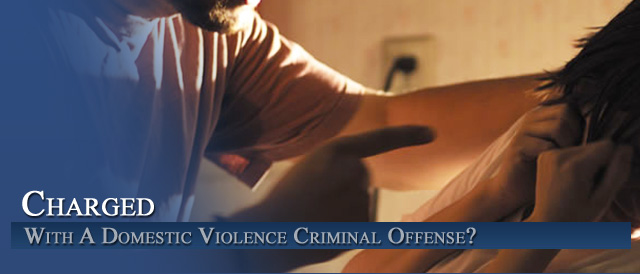




Dual Arrests – Colorado Domestic Violence Arrest Mistakes – The Predominant Aggressor Law – Revisited
By H. Michael Steinberg Colorado Domestic Violence Criminal Defense Lawyer – Attorney
 Dual Arrests – Colorado’s Domestic Violence Arrest Mistakes – The Predominant Aggressor Law – Revisited – Colorado police officers investigating domestic violence cases are in the most difficult position that can exist for a cop – they feel as if their hands are tied by the law and their discretion has been taken away. But there has been a shift in the right of the police to decide who to arrest and who to treat as a victim. This restored discretion is called “predominant” aggressor analysis.
Dual Arrests – Colorado’s Domestic Violence Arrest Mistakes – The Predominant Aggressor Law – Revisited – Colorado police officers investigating domestic violence cases are in the most difficult position that can exist for a cop – they feel as if their hands are tied by the law and their discretion has been taken away. But there has been a shift in the right of the police to decide who to arrest and who to treat as a victim. This restored discretion is called “predominant” aggressor analysis.
This article addresses the very complex “predominant aggressor” law § 18-6-803.6 – which, if used carefully and intelligently by police first responders, can prevent the wrong person from being arrested in a Colorado domestic violence case. This article also looks at the problem of “dual arrests” where the police arrest both the perpetrator and victim – sometimes out of frustration – sometimes out of ignorance.
Defending The Domestic Violence Victim Who Is Mistakenly Charged
While there is no doubt that the Colorado police have a difficult task in investigating domestic violence cases, an analysis called “predominant aggressor’ analysis, an emerging investigative theory, provides a method to not only scrutinize the decisions made by law enforcement in domestic violence cases but to help these officers assign proper legal responsibility for what occurred.
Many times in the cases that I handle, I see clients are literally in shock sitting in court in disbelief that they have been charged with a crime. And while I have written about how this can happen in difference kinds of cases – it seems to happen most often in domestic violence cases.
Colorado Police: “If We Get Called, We Have to Take Somebody In”
One thing is clear, the arrest of victims of domestic violence should be avoided at all costs. But the task of arresting the most culpable party is difficult.
While it is equally clear that the police are trying to do the right thing, mistakes are made. There are generational impacts when children see their abused mother arrested along with the offender knowing she was only trying to protect them and to survive herself. When children see this, they view the police ‘the bad guys,’”
On the other hand, when police officers take the time to do a careful investigation – and arrest only the predominant aggressor, this builds trust among these children and their families – who have already been severely traumatized by domestic violence.
A simplistic investigation of a complex crime such as domestic violence allegations can end with tragic results at several levels. When the police believe they must make an arrest and approach the case with this mandate in mind, they may ignore the devastating impact of not taking their time to properly analyze what is in front of them.
“Predominant Aggressor” analysis gives these officers a new tool.
The Origin Of Predominant Aggressor Laws
To understand the importance of predominant aggressor analysis, and why these laws are being enacted all over the country, one has to briefly review the history of Colorado domestic violence law.
To date, Colorado, like almost every state in the country, requires the police to make an arrest where the police have probable cause to believe that an act of domestic violence has occurred. These “mandatory arrest” laws were enacted several decades ago – (the mid-1980’s), and until very recently, at least in Colorado, did not contain the provision that is the subject of this article. A provision that restores some discretion to the police – allowing the police to limit arrests to the person determined to have been the “predominant aggressor” and thus avoid dual arrests.
As noted – Colorado IS one of the states that have enacted a predominant aggressor law sometimes called Primary Aggressor Laws (see below – § 18-6-803.6. Duties of Peace Officers and Prosecuting Agencies).
Academic research supports the theory behind this newly enacted predominant aggressor law but it is unclear whether the police understand it or have been trained on how to use it.
Where these laws have been enacted “dual arrests” – arresting both parties, are reduced substantially as compared to states that have not enact these laws.
The impact of domestic violence crime mandatory arrest law states has resulted in a huge increase in the number of arrests of both men and women. Mandatory arrest policies in domestic violence cases have caused the number of arrests of men to increase by 37%, while the number of arrested women soared by 446%.
The aggressive enforcement of domestic violence mandatory arrest laws results in the arrest of many women – women who may meet or not meet the technical elements of the crimes for which they are arrested but who are, many times, “re-victimized” by the system.
Colorado is fortunate enough to pair it’s predominant domestic violence aggressor law- § 18-6-803.6.– to the state’s mandatory domestic violence arrest laws. The new law restores police discretion to the first responders, the police who are in the best position to determine the relative relationship and relative power of the parties involved.
Understanding The Role Of Self Defense In Colorado Domestic Violence Cases- Where The Mistake Is Made
In Colorado domestic violence cases, self defense is one of the chief theories used to defend people I will call “charged victims.” But self defense is complex and sometimes the nature of self defense requires a deeper analysis of the evidence.
This article uses urges the use of “predominant aggressor” analysis to determine who should have been charged in the domestic violence case. It is important to note from the start, a “predominant aggressor” in not the first person to use force, (that would be the “initial aggressor which issue may arise in a self defense case.”)
Colorado domestic violence cases are among the most dangerous and complex investigations facing the police. That is why both police officers and prosecutors require much more training in “domestic violence dynamics” to do their jobs well.
Understanding the nature of such areas of study as “mutual combat,” self defense, the science of strangulation, the reasons why women are often forced to use violence, distinguishing between offensive and defensive injuries, and understanding the methods of the “sophisticated batterer” and many more areas of research – is necessary to properly assign criminal accountability and to solve the domestic violence crimes they are faced with each night.
Identifying The Pre-Dominant Aggressor – The Person Who SHOULD Be Arrested
So what does the police officer do when both parties allege self-defense in a DV case?
The answer is this – conduct an intelligent and thorough investigation into the facts and all of the evidence in the case. There will obviously be rare times when it may appear that a the victim uses more substantial actual force than her batterer. These are among the most difficult cases because the police may wrongly identify her as the predominant aggressor and charge her even though in the total context of the relationship (uncovered by an accurate history of abuse) the partner as the real abusive party.
In summary, there will be times when a victims of domestic violence will act preemptively or will assault their abusers to prevent themselves from being assaulted again – or when they feel threatened by their batterers. A response with force can occur out of fear or in an effort to try to defend against the violence the victim knows is coming next.
Here is when the mistake is made. There will be times when a domestic violence survivor will use force which may appear at first blush to have been “more substantial” than the force used by the so called victim. With a little more investigation – given the totality of the circumstances and in the total context of their relationship (after the criteria, below, are applied), it may appear that the force was necessary – it is then that the batterer becomes the predominant aggressor and the person who should be arrested and charged.
The predominant aggressor is the one who controls and dominates the other over time usually with massive methods of control and with overwhelming violence.
Colorado’s Pre-Dominant Aggressor Law Contains Limited Factors To Assist Police
§ 18-6-803.6 (2) C.R.S.
(2) If a peace officer receives complaints of domestic violence from two or more opposing persons, the officer shall evaluate each complaint separately to determine if a crime has been committed by one or more persons.
In determining whether a crime has been committed by one or more persons, the officer shall consider the following:
(a) Any prior complaints of domestic violence;
(b) The relative severity of the injuries inflicted on each person;
(c) The likelihood of future injury to each person; and
(d) The possibility that one of the persons acted in self-defense.
(3) (a) A peace officer is authorized to use every reasonable means to protect the alleged victim or the alleged victim’s children to prevent further violence…..
Colorado’s Pre-Dominant Aggressor Law provides (above) for FOUR areas of inquiry to help the police evaluate competing allegations of domestic violence, however there are many more questions to ask and areas to investigate in my opinion to reach the appropriate decision using pre-dominant aggressor analysis.
The research I have performed in this area would suggest the following areas of inquiry to properly uncover the factors and questions to reach the pre-dominant aggressor decision:
Some questions to ask:
- Have there been threats to kill, commit suicide or take the children?
- Have arguments been laced with coercive and harmful profanities that demean the victim?
- Have there been attempts to control one’s movement, associations or social interactions?
- Do the facts of the case imply that one is motivated out of the need for dominant attention?
- Is the relationship dominated by jealousy and control?
- Have attempts to separate been met with an increased severity of violence?
Have the officers considered?
- The age, height & weight of the parties
- The criminal history of each person.
- Whether either party has been on domestic violence probation.
- The role of corroboration through other evidence and or testimony.
- The presence of fear.
- Motive to relative strength and skill of the parties.
- The use of alcohol or drugs
- Who was the 911 reporting party?
- The role of the timing of the arrest.
- The relative demeanor of parties. (Such as one party has a fearful demeanor or controlling demeanor).
- The existence of protective orders.
- The consistency and inconsistence in the details of each statement.
- Who is seeking to stop the violence
- Who is seeking to avoid punishment?
- Who has motive to lie or retaliate?
- What led up to the violent episode?
- Who is the person most likely to inflict injury?
- Who is the person least likely to be afraid?
- Is there any character evidence or known propensity for violence?
- Who has access to or control of resources?
- Were there threats made against other family members or pets.
Returning Discretion To The Police
It is clear that police officers are trained observers of human behavior. They acquire this skill from interacting with people who are in crisis on a daily basis. I believe the police are, most of the time, trying to arrest the right person …and if given the correct training, they will.
For example most police on the street police know that “mutual abuse” – that is where the parties regularly beat each other up on an equal basis – is very rare and should almost never be used to somehow justify mutual arrests.
“Mutual abuse” is exactly what you probably think it is. The parties to domestic violence are almost NEVER on an equal footing for many, many reasons.
While domestic violence survivors may wonder if they are in a “mutually abusive relationship” – this self doubt may actually be the result of something called “gas lighting.” Victims are made to feel by their abuser that their abusive relationship is somehow “normal.”
In the vast majority of cases, it is not. The truth is, true “mutual abuse” is extremely rare and many experts don’t even believe it exists.
Police will sometimes use this theory to wash their hands of the more difficult predominant aggressor analysis – finding that the partners are “mutually abusive” or somehow equal in the violence. This myth of mutual abuse not only reinforces the criminal behavior of the batterer – it provides a means to justify that his or her actions were justified.
Summary And Conclusion – Dual Arrests – Colorado’s Domestic Violence Arrest Mistakes – The Predominant – Predominant Aggressor Law – Revisited
It is well known to those of us in this field that domestic violence calls are among the most common and the most dangerous calls to which law enforcement officers must respond. They are also the most frustrating for the police and this is especially true when they have been called to the same house many times.
Whether the person targeted for being charged with a crime of domestic violence is arrested must turn, not on a cursory investigation of the case that can and often does lead to an erroneous arrests, but the decision to arrest must be as a result of the kind of investigation that utilizes predominant aggressor analysis or other investigative tools that restore discretion to the police and counters the blunt decisions made by police officers who find they must make an arrest based on the mandatory arrest laws.
Here Is The Entire Law – § 18-6-803.6.
§ 18-6-803.6. Duties of Peace Officers and Prosecuting Agencies – Preservation of Evidence.
(1) When a peace officer determines that there is probable cause to believe that a crime or offense involving domestic violence, as defined in section 18-6-800.3 (1), has been committed, the officer shall, without undue delay, arrest the person suspected of its commission pursuant to the provisions in subsection (2) of this section, if applicable, and charge the person with the appropriate crime or offense.
Nothing in this subsection (1) shall be construed to require a peace officer to arrest both parties involved in an alleged act of domestic violence when both claim to have been victims of such domestic violence.
[HMS – Defining what Domestic Violence really “is” – becomes critical to defending the Colorado Domestic Violence Case]
§ 18-6-8003 Definitions(1) “Domestic violence” means an act or threatened act of violence upon a person with whom the actor is or has been involved in an intimate relationship. “Domestic violence” also includes any other crime against a person, or against property, including an animal, or any municipal ordinance violation against a person, or against property, including an animal, when used as a method of coercion, control, punishment, intimidation, or revenge directed against a person with whom the actor is or has been involved in an intimate relationship. (2) “Intimate relationship” means a relationship between spouses, former spouses, past or present unmarried couples, or persons who are both the parents of the same child regardless of whether the persons have been married or have lived together at any time. |
Additionally, nothing in this subsection (1) shall be construed to require a peace officer to arrest either party involved in an alleged act of domestic violence when a peace officer determines there is no probable cause to believe that a crime or offense of domestic violence has been committed.
The arrested person shall be removed from the scene of the arrest and shall be taken to the peace officer’s station for booking, whereupon the arrested person may be held or released in accordance with the adopted bonding schedules for the jurisdiction in which the arrest is made.
[HMS – The next section is Colorado’s Predominant Aggressor Law ….]
(2) If a peace officer receives complaints of domestic violence from two or more opposing persons, the officer shall evaluate each complaint separately to determine if a crime has been committed by one or more persons. In determining whether a crime has been committed by one or more persons, the officer shall consider the following:
(a) Any prior complaints of domestic violence;
(b) The relative severity of the injuries inflicted on each person;
(c) The likelihood of future injury to each person; and
(d) The possibility that one of the persons acted in self-defense.
(3) (a) A peace officer is authorized to use every reasonable means to protect the alleged victim or the alleged victim’s children to prevent further violence. Such peace officer may transport, or obtain transportation for, the alleged victim to shelter. Upon the request of the protected person, the peace officer may also transport the minor child of the protected person, who is not an emancipated minor, to the same shelter if such shelter is willing to accept the child, whether or not there is a custody order or an order for the care and control of the child or an order allocating parental responsibilities with respect to the child and whether or not the other parent objects. A peace officer who transports a minor child over the objection of the other parent shall not be held liable for any damages that may result from interference with the custody, parental responsibilities, care, and control of or access to a minor child in complying with this subsection (3).
(b) For purposes of this subsection (3), “shelter” means a battered women’s shelter, a friend’s or family member’s home, or such other safe haven as may be designated by the protected person and which is within a reasonable distance from the location at which the peace officer found the victim.
[HMS – The Law Also Emphasizes Gathering Physical Evidence To Uncover The Truth.]
(4) (a) The arresting agency shall make reasonable efforts to collect and preserve any pertinent evidence until the time of final disposition of the matter, including, but not limited to, the following:
(I) Any dispatch tape recording relating to the event;
(II) Any on-scene video or audio tape recordings;
(III) Any medical records of treatment of the alleged victim or the defendant; and
(IV) Any other relevant physical evidence or witness statements
(b) However, in the absence of bad faith, any failure to collect or preserve any evidence listed in paragraph (a) of this subsection (4) shall not be grounds to dismiss the matter.
(4.5) When a peace officer responds to a call or is otherwise responding to a report about an alleged offense involving domestic violence, as defined in section 18-6-800.3 (1), or other domestic dispute, the officer shall include in his or her written or oral report concerning such incident whether children may have seen or heard the alleged offense; except that, in the absence of bad faith, the failure of a peace officer to note that a child may have seen or heard the alleged offense shall not be grounds to dismiss the matter.
(5) A peace officer shall not be held civilly or criminally liable for acting pursuant to this section if the peace officer acts in good faith and without malice.
Dual Arrests – Colorado Domestic Violence Arrest Mistakes – The Predominant – Predominant Aggressor Law – Revisited
If you found any of the information I have provided on this web page article helpful please click my Plus+1 or the Share buttons for Twitter and Facebook below so that others may also find it.
The contents of this article are based upon my research, my personal experience and my personal analysis and opinions developed from my thirty six years (as of 2017) of criminal trial experience from both sides of the courtroom – as a former career prosecutor for Arapahoe and Douglas Counties (13 years) and as the owner of my own Criminal Defense Law Firm since 1999 (18 years).
The reader is also admonished that Colorado criminal law, like criminal law in every state and at the Federal level, changes constantly. The article appearing above was accurate at the time it was drafted but it cannot account for changes occurring after it was uploaded.
If, after reading this article, you have questions about your case and would like to consider retaining our law firm, we invite you to contact us at the Steinberg Colorado Criminal Defense Law Firm – 303-627-7777.
Never stop fighting – never stop believing in yourself and your right to due process of law. You will not be alone in court, H. Michael will be at your side every step of the way – advocating for justice and the best possible result in your case. H. Michael Steinberg is passionate about criminal defense. His extensive knowledge and experience of Colorado Criminal Law gives him the edge you need to properly handle your case
A BOUT THE AUTHOR: H. Michael Steinberg – Email The Author at:
BOUT THE AUTHOR: H. Michael Steinberg – Email The Author at:
A Denver Colorado Criminal Defense Lawyer – or call his office at 303-627-7777 during business hours – or call his cell if you cannot wait and need his immediate assistance – please call 720-220-2277.
“A good criminal defense lawyer is someone who devotes themselves to their client’s case from beginning to end, always realizing that this case is the most important thing in that client’s life.”
You should be careful to make a responsible choice in selecting a Colorado Criminal Defense Lawyer. We encourage you to “vet” our firm. Over the last 36 plus years – by focusing ONLY on Colorado criminal law – H. Michael has had the necessary time to commit to the task of constantly updating himself on nearly every area of criminal law, to include Colorado criminal law and procedure and trial and courtroom practice.
Putting more than 36 years of Colorado criminal defense experience to work for you.
H. Michael works hard to get his clients the best possible results in and out of the courtroom. He has written, and continues to write, extensively on Colorado criminal law and he hopes this article helps you in some small way – Dual Arrests – Colorado Domestic Violence Arrest Mistakes – The Predominant – Predominant Aggressor Law – Revisited.

Other Articles of Interest:
- How Mistakes Are Made In Colorado Domestic Violence Arrests – Predominant Aggressor Analysis
- Colorado Criminal Law Guide – Self Defense and Domestic Violence Charges
- How DO The Police Evaluate Colorado Domestic Violence Cases? – The Law 18-6-803.6
- Colorado Domestic Violence Cases- The Arrest
- Understanding The Laws, Politics And Policies Behind Domestic Violence Cases – No Room For Justice Here*












